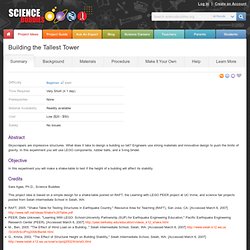

Shake, Rattle and Slide. Faultline: Earthquake Engineering. Building for the Big One What do San Francisco, Tokyo, and Istanbul have in common?

They are the three most densely populated cities on the planet where seismologists expect major earthquakes. While the events that will inevitably shake these cities may be similar, the tolls they will take on the cities’ populations and infrastructures will be very different. Why? The answer lies in how their buildings and bridges are designed. Most of the damage we associate with earthquakes involves human-built structures: people trapped by collapsed buildings or cut off from vital water or energy supplies. It might seem obvious to say that earthquakes do most of their damage by shaking the ground. When the ground beneath a building shakes, it makes the building sway as the energy of a quake’s waves moves through it. The taller a structure, the more flexible it is. Of course, the materials a building is constructed from also determine its strength, and again, flexibility is important.
How does Earthquake occur with explanation - Social Science 3D animation video in HD. Building the Tallest Tower. Please ensure you have JavaScript enabled in your browser.

If you leave JavaScript disabled, you will only access a portion of the content we are providing. <a href="/science-fair-projects/javascript_help.php">Here's how. </a> Abstract Skyscrapers are impressive structures. Objective In this experiment you will make a shake-table to test if the height of a building will affect its stability. Credits Sara Agee, Ph.D., Science Buddies This project idea is based on a simple design for a shake-table posted on RAFT, the Learning with LEGO PEER project at UC Irvine, and science fair projects posted from Selah Intermediate School in Selah, WA: RAFT, 2005. Introduction Once the tallest buildings in the world, the Petronas Towers in Kuala Lumpur, the capital of Malaysia, stand at 1,483 feet, which beat out the Sears Tower in Chicago, which previously held the record for the tallest building at 1,454 feet (WGBH, 2000). An engineer designs a building to withstand forces.
Terms and Concepts Bibliography. How do you build an Earthquake-proof building? : Imagination Station. How do you build an Earthquake-proof building?

After the massive earthquake near Japan this morning one wonders if it’s possible to build an earthquake-proof building? The answer is yes and no. There are of course, engineering techniques that can be used to create a very sound structure that will endure a modest or even strong quake. However, during a very strong earthquake, even the best engineered building may suffer severe damage. Engineers design buildings to withstand as much sideways motion as possible in order to minimize damage to the structure and give the occupants time to get out safely. Effect of isolating the base of a building subject to a sideways ground movement. Buildings are basically designed to support a vertical load in order to support the walls, roof and all the stuff inside to keep them standing.
The most dangerous building construction, from an earthquake point of view, is unreinforced brick or concrete block. Skyscrapers Can you build a better building?